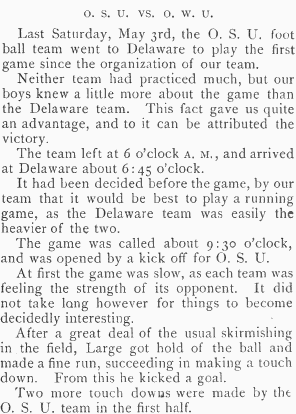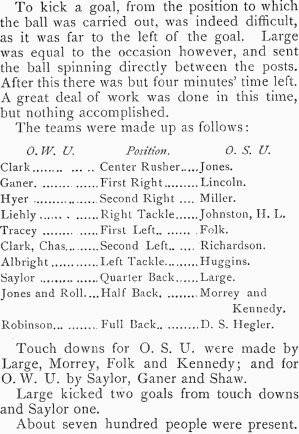First Football Game - May 3, 1890


In the era when the game was played, a touchdown was awarded 4 points and the kick after a touchdown was awarded 2 points. So, Ohio State had 4 touchdowns for 16 points and 2 successful kicks for 4 points for a total of 20 points. Ohio Wesleyan had 3 touchdowns for 12 points and 1 successful kick for 2 points for a total of 14 points.
A point pf note, when a kick was made after a touchdown, it was made from the point of the field where the touchdown was scored crossing the goal line (as done in Rugby). So, the angle from near the side lines would make for a difficult kick. To adjust for the angle, the kick can be taken from any distance of the kicker's choosing. Unlike today, where the point after attempt (try) is done on the eight yard line in front of the goal posts).
Some of the history of American football is summarized from Wikipedia, follows:
Football of this era resembled Rugby Union rules as adopted in 1874 by Harvard, Princeton, Yale and Columbia. Thus, a person from today watching the first Ohio State - Ohio Wesleyan game would not recognize it as the sport of today. Much of the action was scrum style, ground gaining football with lateral and behind the line of scrimmage passing. Also, as in Rugby, a great deal of kicking to gain field position. Rugby, would adopt the try (touchdown) as it primary means of scoring after the adoption in early American football. Prior to this adoption, the primary means of scoring was kicking the ball through the goal posts. So, while the British invented Rugby, it was the Americans which evolved the try (touchdown). The term "try" in American football refers to the point after attempt; in Rugby it is called a "conversion". The "field goal" does not exist in Rugby; the closest equivalent is a "penalty kick"; both are scored three points today. Initially, field goals/penalty kicks were scored five points.
By 1881, Walter Camp (Coach of Yale University) changed the field size and scoring rules which would have been followed by Ohio State and Ohio Wesleyan in 1890. The field size was to today's dimensions. Scoring, is as noted above. The game would be played in two 45 minute halves, with a constant running clock (as down in Soccer and Rugby). At the dawn of the 20th century American football would evolve away from Rugby. First, by playing on a gridiron field. The lines on the field would be ten years apart. In the location where there would be hash marks, is a solid line effectively diving the field into thirds; thus making the field looking like a gridiron.
Football, though, was much more violent prior to 1906 because of mass formations. That is, the two opposing teams would run toward each other as a unit. The result were violent collisions. These games were known to create serious injuries and, in some cases, death of players. John Sigrist, captain of the 1898 football team, was the only Ohio State player seriously injured, and would die, as the result of a spinal injury which occurred during a course of the Western Reserve football game on 26 October, 1901; Mr. Segrist died on 28 October, 1901. The Ohio State University Lantern obituary is available here . Also, on 28 October, 2011, The Columbus Dispatch published a retrospective on the 110th Anniversary of John Sigrist's death and is available here.
In 1906, President Roosevelt was ready to shutdown the game, because 13 players died during the 1905 season. A meeting of 62 college programs resulted in major chnages to the game. The inception of the forward pass, and banning of mass formations ("the flying wedge" being the most notable from this era), revolutionized the game of American football. It also increased the safety in the game.
Additional historical information about the early days of college football can be found on Wikipedia here.
More historical information about the first football game is available here.
Please e-mail any comments, problems or suggestions to njmetrowsky@gmail.com
Webmaster: Nick Metrowsky
The Ohio State University, BA, History, 1979
Life Member The Ohio State University Alumni Association
Life Member of The Ohio State University President's Club
Annual Member of The Ohio State University Varsity "O" Association
Last Updated: 23 September, 2021


